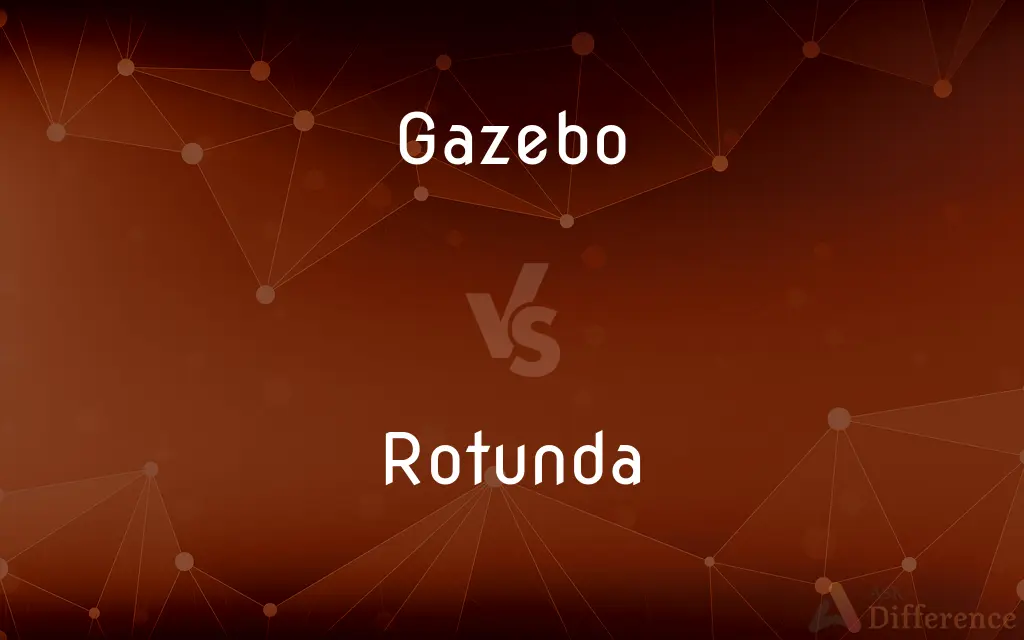Gazebo vs. Rotunda — What's the Difference?
By Maham Liaqat & Fiza Rafique — Updated on March 13, 2024
A gazebo is a freestanding, open garden structure for shelter and decoration, often octagonal, while a rotunda is a round building or room, especially one with a dome.

Difference Between Gazebo and Rotunda
Table of Contents
ADVERTISEMENT
Key Differences
A gazebo is an outdoor structure, typically found in gardens, parks, or spacious public areas, designed to offer a picturesque view and shelter from the sun or rain. Gazebos are often octagonal or hexagonal in shape and have a roof. They are primarily used for relaxation and as decorative features in landscape design. On the other hand, a rotunda refers to any round building or room, characterized by its circular ground plan, and often capped with a dome. Rotundas are architectural features found in various contexts, including public buildings, museums, and memorials, serving both aesthetic and functional purposes.
Gazebos are commonly made of wood, metal, or vinyl, featuring open sides that may be adorned with railings or balustrades. They are intimate spaces, typically accommodating small gatherings, offering an ideal spot for enjoying the outdoors, reading, or holding conversations. Rotundas, however, are constructed from a variety of materials depending on their location and purpose, including stone, brick, and concrete, and can accommodate larger groups due to their typically more spacious interior.
The design of a gazebo is focused on blending with the natural environment, providing a comfortable and sheltered outdoor space. In contrast, the rotunda's design emphasizes architectural grandeur and significance, often serving as a focal point of a building or landscape due to its distinctive circular shape and dome.
Functionally, gazebos serve as a peaceful retreat in outdoor settings, often found in residential gardens or public parks. They may host small events, such as weddings or picnics. Rotundas, however, are versatile in function, serving as public meeting spaces, exhibition halls, or commemorative structures. Their design can enhance the acoustics for speeches or music, making them suitable for ceremonies and performances.
While both gazebos and rotundas are structures designed to occupy distinct spaces in architecture and landscaping, their purposes, designs, and typical settings differ significantly. Gazebos are primarily recreational and decorative outdoor structures, whereas rotundas are architectural elements with a broader range of functions, often associated with cultural or historic significance.
ADVERTISEMENT
Comparison Chart
Definition
A freestanding, open-sided structure, often with a roof.
A round building or room, usually with a dome.
Shape
Typically octagonal or hexagonal.
Circular ground plan.
Material
Wood, metal, vinyl.
Stone, brick, concrete.
Function
Offers shelter and a place for relaxation in outdoor areas.
Serves various functions, including as meeting spaces or monuments.
Setting
Gardens, parks, residential areas.
Public buildings, museums, memorials.
Design Focus
Integration with the natural environment.
Architectural grandeur and significance.
Usage
Small gatherings, decorative feature.
Larger gatherings, ceremonies, exhibitions.
Compare with Definitions
Gazebo
Enhances the landscape design by adding a decorative element.
Adding a gazebo significantly improved the backyard's look and utility.
Rotunda
A circular building or room, often featuring a dome.
The museum's rotunda housed an impressive sculpture collection.
Gazebo
Often octagonal, enhancing its aesthetic appeal.
The octagonal gazebo became the park's focal point.
Rotunda
Accommodates a variety of public and ceremonial functions.
The rotunda served as a grand venue for the art exhibition.
Gazebo
Made from materials like wood or metal, suited to outdoor conditions.
The wooden gazebo blended perfectly with the natural surroundings.
Rotunda
Known for enhancing acoustics, suitable for performances.
The choir's performance in the rotunda was mesmerizing, thanks to the acoustics.
Gazebo
A garden structure offering shelter and scenic views.
They enjoyed tea in the garden's gazebo, admiring the flowers.
Rotunda
Built with durable materials like stone or brick.
The ancient rotunda stood firm, its stone facade weathering centuries.
Gazebo
Serves as a venue for intimate outdoor events.
Their wedding ceremony was held in the beautiful park gazebo.
Rotunda
Architecturally significant, symbolizing unity and strength.
The capitol's rotunda was designed to symbolize the state's unity.
Gazebo
A gazebo is a pavilion structure, sometimes octagonal or turret-shaped, often built in a park, garden or spacious public area. Some are used on occasions as bandstands.
Rotunda
A round building; especially, one that is round both on the outside and inside, like the Pantheon at Rome. Less properly, but very commonly, used for a large round room; as, the rotunda of the Capitol at Washington.
Gazebo
A freestanding, roofed, usually open-sided structure providing a shady resting place.
Rotunda
A circular building or room, especially one topped with a dome.
Gazebo
A belvedere.
Rotunda
(architecture) A round building, usually small, often with a dome.
Gazebo
A belvedere, either a type of summer-house or a roofed, detached porch-like structure, usually in a yard, park or lawn.
Rotunda
A Gothic typeface used in early printed books in Northern Italy, based on a rounded script developed in the 13th cent.; the manuscript hand on which this typeface was based.
Gazebo
A small roofed building affording shade and rest
Rotunda
(Philippines) A roundabout; a road junction at which traffic streams circularly around a central island.
Rotunda
(geometry) A form of cupola that has pentagons rather than squares or rectangles.
Rotunda
A building having a circular plan and a dome
Rotunda
A large circular room
Common Curiosities
Do gazebos serve any functional purpose besides being decorative?
Yes, gazebos provide shelter from the sun and rain, making them functional spaces for relaxation and gatherings.
What primarily distinguishes a gazebo from a rotunda?
A gazebo is an open-sided, roofed structure often in a garden, while a rotunda is a round building or room, typically with a dome.
Can gazebos only be found in private gardens?
No, gazebos can be found in both private gardens and public parks or landscapes.
Is the circular shape of a rotunda significant in architecture?
Yes, the circular shape of a rotunda is architecturally significant, often symbolizing unity, eternity, or perfection.
Can a gazebo have sides?
Gazebos can have open sides or be equipped with screens, glass, or other materials to protect against insects or weather.
Are all rotundas large and publicly accessible?
While many rotundas are large and public, some can be private or part of a building not accessible to the public.
What are common materials used in building a rotunda?
Common materials include stone, brick, and concrete, chosen for durability and aesthetic appeal.
How does the design of a rotunda contribute to its acoustics?
The circular shape and dome of a rotunda can enhance sound distribution, making it ideal for speeches and music.
Are rotundas used for specific types of events?
Rotundas can host a variety of events, including exhibitions, ceremonies, and performances, benefiting from their spacious interiors and acoustics.
Can a gazebo be used for events?
Yes, gazebos are popular venues for small events like weddings and picnics.
Is there a difference in the typical locations of gazebos and rotundas?
Yes, gazebos are typically located in gardens or parks, while rotundas can be part of larger buildings or standalone structures in public spaces.
What makes a gazebo suitable for outdoor relaxation?
Its open sides and roof provide protection while allowing for an immersive natural experience.
Why might someone choose a gazebo for their garden?
A gazebo offers a picturesque and functional outdoor retreat, enhancing the garden's aesthetic and usability.
Share Your Discovery

Previous Comparison
Dread vs. Bread
Next Comparison
Probability vs. ImprobabilityAuthor Spotlight
Written by
Maham LiaqatCo-written by
Fiza RafiqueFiza Rafique is a skilled content writer at AskDifference.com, where she meticulously refines and enhances written pieces. Drawing from her vast editorial expertise, Fiza ensures clarity, accuracy, and precision in every article. Passionate about language, she continually seeks to elevate the quality of content for readers worldwide.















































